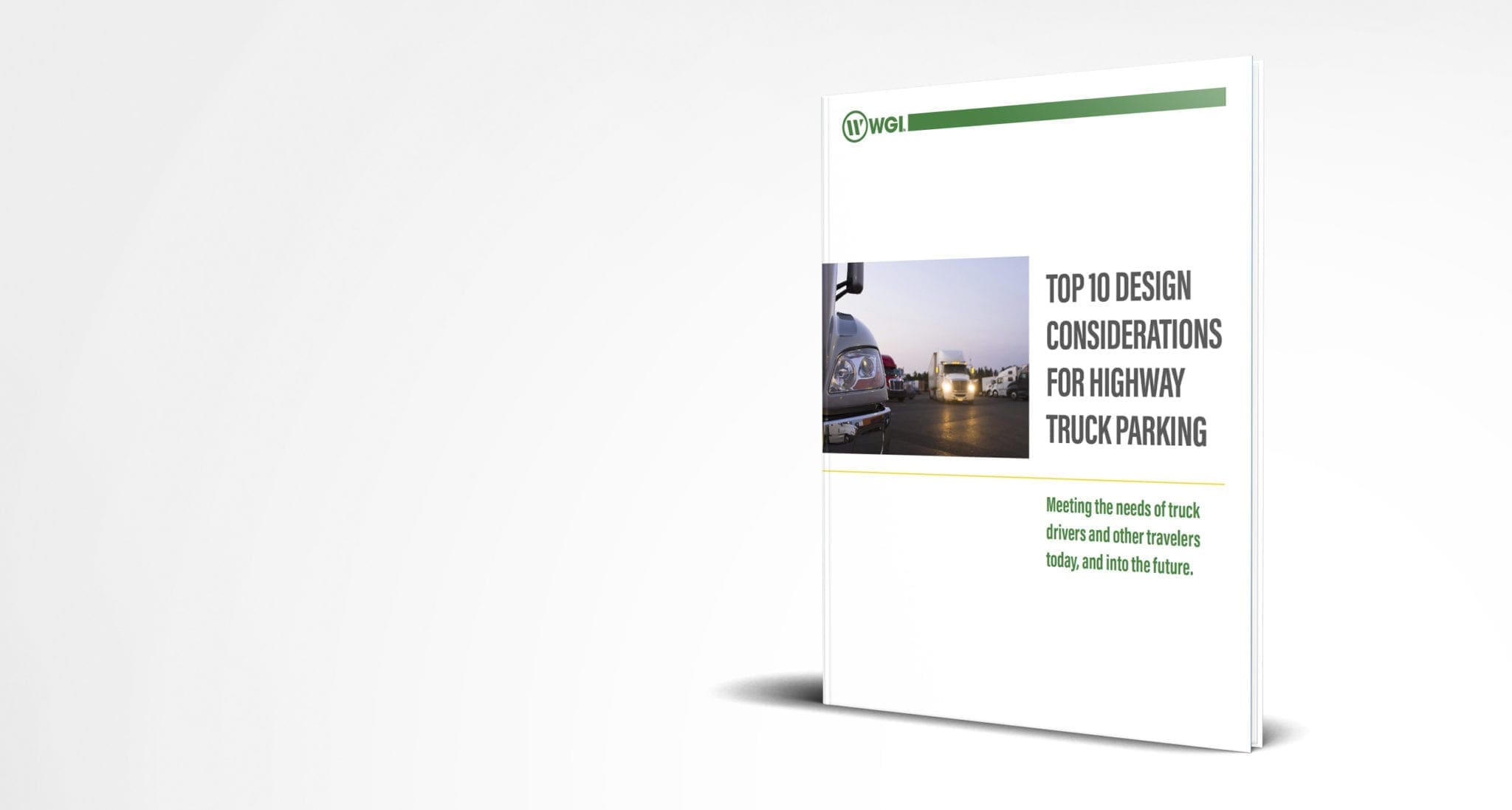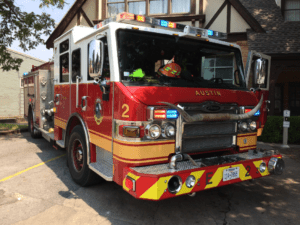
2017 FTBA Best in Construction Awards
WGI was recognized for awards in the Interstate, Design-Build, and Alternative Contracting categories.
Learn from award-winning professionals — explore our whitepapers, blogs, and the latest industry updates.
Join our dynamic organization of engineers, land surveyors, landscape architects, environmental scientists, and architects!
Talk to a market leader today! We’ll answer any questions you have about our professional services.


Top 10 Design Considerations For Highway Truck Parking: Meeting the needs of truck drivers and other travelers today, and into the future.
PLANNING FOR SAFER HIGHWAYS
Anyone spending significant time driving on America’s highways sees firsthand the dangers of fatigued driving. It’s unavoidable — approximately one in every five fatal vehicular crashes involve driver fatigue; a third of crashes involving a drowsy driver result in injuries. According to the National Highway Traffic Safety Administration, tired drivers are responsible for over 70,000 crashes a year, causing nearly 45,000 injuries. The Centers for Disease Control and Prevention estimates that up to 6,000 fatal crashes each year are caused by drowsy drivers.
In response to this significant daily threat, state and federal transportation administrators and policymakers took action to reduce tired driving, particularly among truck drivers. In this regard, the most important policy is limiting the length of time drivers can legally drive before taking a rest. State regulations vary, but the federal government established stringent rules. They include limits of 60 hours of driving over a seven consecutive-day period, or 70 hours over eight days. Also, drivers may be on duty for up to 14 hours — with a mandatory 30-minute break by their eighth hour — following 10 hours off duty.
In the vital quest to save lives, an obvious shortcoming emerged. On too many highways, both state and federal, there aren’t enough rest areas to serve the needs of high-volume truck traffic mandated to take a break. It’s not uncommon to see highway rest stops overwhelmed with trucks, and miles of freeway shoulders adjacent to rest areas lined with trucks. This poses a significant safety hazard to both truck drivers, and the private-vehicle drivers traveling on those same roads.
PLANNING FOR THE FUTURE
In response, many states are planning the creation of new or expanded rest areas to better serve both truckers and fatigued private-vehicle drivers. State planners and their consulting engineers are preparing programs to deliver on these improvements.
Of course, significant planning goes into rest-area development. It’s not a matter of just paving over a field and painting parking stall stripes. They require restrooms and sanitary services; many have restaurants and retail establishments; some have recreational areas or learning centers (environmental stewardship programs); and some even have fuel and other vehicle-maintenance operations.
Planners must consider not just a rest area’s initial use, but regulations governing commercialization the of the right-of-way along the Interstate System. In addition, they should also anticipate long-term utilization over the next five, 10, 15, and more years with an eye toward developing and future technologies that may affect the project.

1. Location
As the saying goes, when it comes to real estate, the three most important considerations are location, location, and location. Each rest area is a connected element within a series of resting places, so it needs to be located in relation to other existing or planned facilities. Ultimately, a system must take into consideration the proximity of all other options and regular stopping locations.
Efficiency considerations, such as facilities serving bi-directional travel, should be evaluated. Developing a system of facilities that serves both directions of travel saves money where regulations allow them, but they present potential issues with capacity and safety, especially the possibility of wrong-way re-entry to the highway. Ultimately, cost considerations should be weighed against the anticipated short- and long-term parking needs for that stretch of highway.

2. PARKING ENGINEERING
Parking geometrics are essential at the earliest stages of planning. Parking engineers need to determine how entrances and exits are configured to assure trucks can maneuver into, throughout, and out of the rest area. As a rule, designers have a duty to account for an average turning radii that is affected by the parking angle and direction. For facilities that serve highways on which tandem trucks are allowed, parking geometrics must offer specific turning radii to address these and additional related factors.
Determining the quantity of truck and car spaces needed (and therefore, vital restroom fixtures), is derived using a state’s required computation method, typically part of its overall Building Facilities Design Manual. WGI conducts extensive research by project location, to work with required formulae that determine the size of a rest area to develop traffic volume computations of travel along the roadway, what types of facilities are available in relatively close proximity (such as private truck stops), and how those numbers are likely to evolve over the rest area’s lifecycle. The answers to these questions influence the number and types of spaces ultimately included in the rest area’s design.
Also, a significant factor is accommodating trucks using the rest area to change out their loads. Often, drivers pull into truck stops, hand over their loads to other trucks, and pick up new loads before heading out — requiring sufficient open space in the design for these rest area swaps. Depending on a project’s unique needs, it could make sense to include temporary storage space so trailers can be left on the lot until the replacement driver arrives to pick it up.
3. WHO ARE YOUR USERS?
By necessity, designers and planners determine whether the facility should accommodate private vehicles as well as trucks. It Is vital to segregate private vehicles and trucks, directing each to a different parking area within the facility. This improves safety within the facility by reducing the risk of collisions between trucks and private vehicles.
4. RESTROOMS
Bathrooms are the most basic and essential service for any new rest area; it is vital there are sufficient facilities to meet the needs of both truck drivers and private-vehicle drivers.
Sanitation is imperative to protecting public health, not just in restrooms, but throughout the facility. Considerations include planning for cleaning-supply storage at convenient locations to service restrooms and other public areas; sufficient trash can quantities and resources for disposing of trash throughout the day; and strategically locating dumpsters for easy access by garbage pick-up vehicles, without impacting traffic in and out of rest area by cars and trucks.
 5. FUEL AND VEHICLE SERVICES
5. FUEL AND VEHICLE SERVICES
Another consideration is whether to provide fuel and, if so, whether to sell regular, diesel, or both — and with the exponential growth of electric vehicles, today’s service/rest areas should consider electric recharging capabilities — including the necessary infrastructure (the wires and necessary equipment) in the initial design. It’s much less expensive to hook into existing infrastructure than to completely retrofit a facility to later add electric charging capabilities.
Many privately owned rest areas offer vehicle-maintenance operations. The most common include oil change, tire change, and emergency services. Considering these services for public rest areas is particularly important in remote areas where there may not be private service stations for many miles.
6. ENVIRONMENTAL CONSIDERATIONS
Environmental management is always an important issue for any development, but particularly for facilities that serve many vehicles. It is vital that the design include stormwater treatment strategies that address the inherent environmental impact on adjacent land and water.
Cars and trucks can leak oil or other fluids, and depending on location, track in corrosive ice and snow-melt chemicals. If they collect in parking areas, they may leak into the surrounding environment during storm events. By planning for prevention, mitigation, and remediation, Departments of Transportation and other owners, prepare for appropriate and long-term environmental stewardship.
7. FOOD SERVICES
Often, drivers who stop are hungry and would like to have a chance to eat a meal or grab a snack. When designing a new rest area, planners should decide whether to include fast-food restaurants and convenience stores in their design.
In addition, many rest areas provide outdoor grills for the personal-vehicle drivers to use. This is an option for people who are likely on personal, pre-planned travel with a bit of time on their hands, and want to enjoy a more recreational experience for their meal.
 8. UTILITIES
8. UTILITIES
It’s essential to have a plan for bringing in power, water, and other utilities. It may be possible to connect to local power utilities, but in more remote locations, the rest area may have to generate its own power through gas- or natural gas-fueled power generation systems, or “green” options like windmills and solar panels. On-site water and wastewater treatment plants may also be necessary where it is not possible to connect to local utilities.
Cellular service is another consideration in more isolated areas. Rest areas can provide ideal cell tower locations, providing service to travelers who stop, as well as those continuing along on their journeys. Leasing land for a cell tower can also be a good revenue source, helping to underwrite the rest area’s operating costs.
9. HOW TO PAY FOR EVERYTHING
It can be expensive to operate a rest area, and most highway departments would prefer their facilities to be revenue neutral. There are a number of ways to achieve revenue neutrality, and they work best when planned in advance.
As mentioned earlier, leasing space for cell towers can generate revenue. Additionally, services that are typically offered at rest areas, such as food, gas, and vehicle maintenance, can generate sufficient revenue to pay for the rest area’s operations when allowed by federal and state regulations. The question then for transportation departments is whether to manage these functions, lease those operations, or create a more active public/private partnership. Ultimately, the approach should be based on each rest area’s unique needs and characteristics.
10. SAFETY AND SECURITY
Safety and security are of paramount importance. Rest areas are used 24 hours a day, 365 days a year. There is a set of conceptual principles known as Crime Prevention Through Environmental Design (CPTED) that should influence design in ways that discourage crime and promote security. Its four main principles are natural surveillance, natural access control, territorial reinforcement, and maintenance.
For example, even when restrooms and other public areas are closed, people use parking areas to rest — so illumination is key to security because brightly lit areas are less likely to attract criminals.
Modern LED lighting technology can significantly improve safety because it emits truer, brighter lighting and reduces shadows. Also, lighting should be strategically placed to eliminate unlit hiding places and shadows. Collisions between vehicles and pedestrians are also less likely when parking areas are brightly lit.
Security cameras also play a significant role in promoting security, particularly when prominently placed so people know their activities are being observed. High-visibility lighting and cameras improve visibility in public areas; the more visible you are, the safer you are.
IN CONCLUSION
Ultimately, every building site is different, and rest area development plans should be built around each site’s unique characteristics. By following these ten tips, most transportation authorities can assure their rest areas will meet the needs of truck drivers and other travelers today, and well into the future.

Top 10 Design Considerations For Highway Truck Parking: Meeting the needs of truck drivers and other travelers today, and into the future.

WGI is a national design and professional services firm leading in technology-based solutions for the construction of public infrastructure and real estate development. At WGI, we’re providing Tomorrow’s Infrastructure Solutions Today.

WGI was recognized for awards in the Interstate, Design-Build, and Alternative Contracting categories.

If your city hasn’t begun planning for autonomous vehicles, it’s not too late — but the time for urgency is fast approaching.

Two WGI projects have been chosen by ACEC to receive National Recognition Awards & are in the running for the Grand Conceptor Award at the 2022 Engineering Excellence Awards Gala.

Success begins with thoughtful planning and design, and the owner’s interests must be well represented at each step in the process.

Municipalities like the City of Austin set specific design standards so these emergency vehicles can maneuver as quickly as possible. Our civil design experts break down some of the requirements.

In April 2019, the City of San Antonio adopted the rainfall values from a study published by the National Oceanic and Atmospheric Administration (NOAA) dubbed as NOAA Atlas 14. The study found that rainfall frequencies in parts of Texas are higher than in previous studies.
You’ve been searching for a place like WGI. We look forward to meeting you soon.
Sign up to receive emails to hear our latest news and achievements in our monthly newsletter.
Enter your zip code, and we’ll personalize your experience with local projects, office locations, team members, and more.
WGI supports its associates with meaningful opportunities for growth, strong benefits and perks, while we work collaboratively with clients and co-consultants to shape and improve communities.






WGI is a dynamic organization with opportunities nationwide for engineers, land surveyors, landscape architects, environmental scientists, and architects.